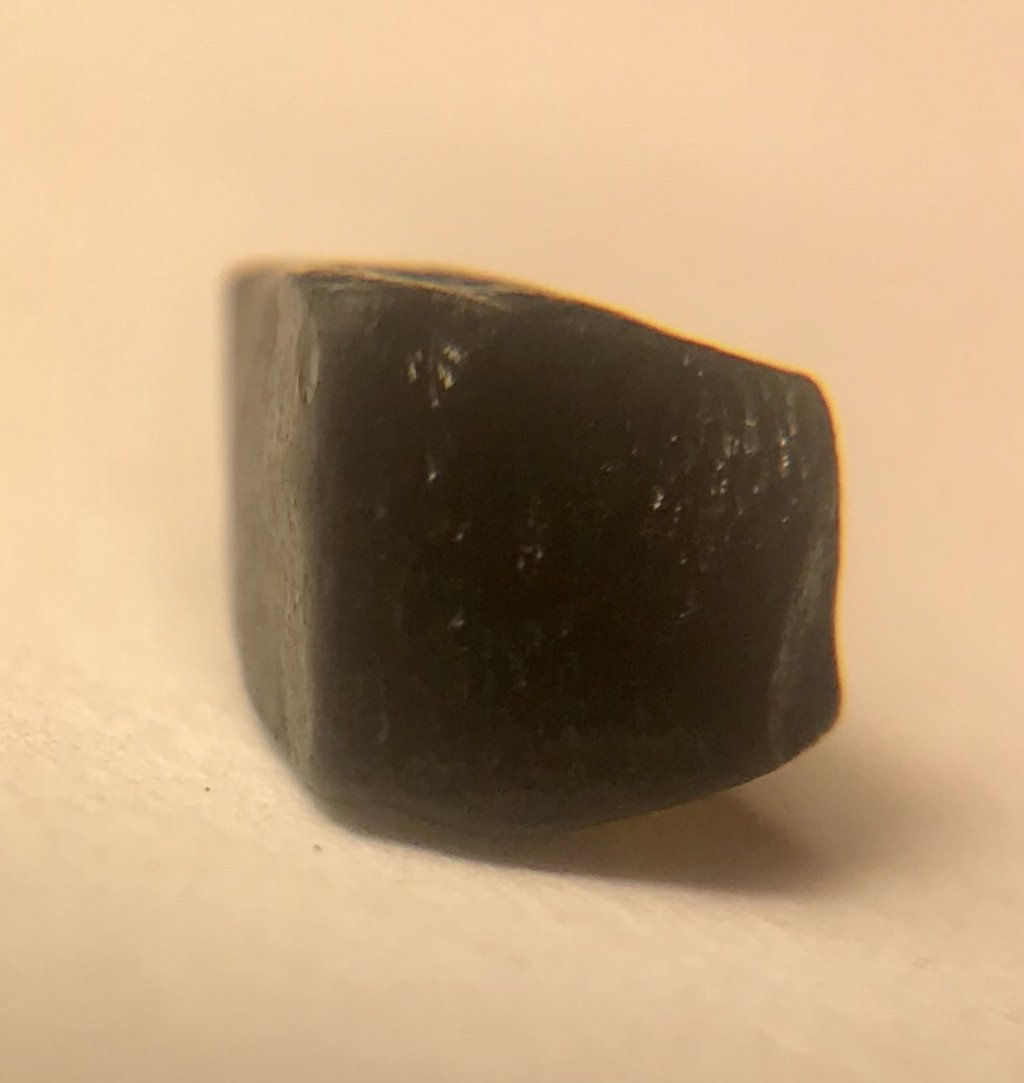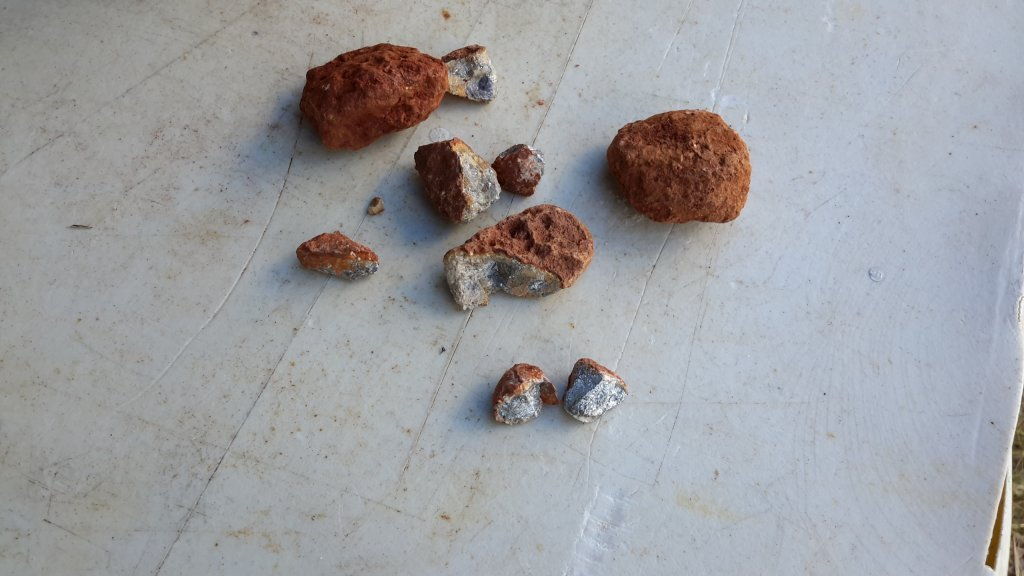-
Please join our new sister site dedicated to discussion of gold, silver, platinum, copper and palladium bar, coin, jewelry collecting/investing/storing/selling/buying. It would be greatly appreciated if you joined and help add a few new topics for new people to engage in.
Bullion.Forum

You are using an out of date browser. It may not display this or other websites correctly.
You should upgrade or use an alternative browser.
You should upgrade or use an alternative browser.
❓Your Mineral Identification Questions answered here
- Thread starter user 4386
- Start date

Help Support Prospecting Australia:
This site may earn a commission from merchant affiliate
links, including eBay, Amazon, and others.
Could be - the hardness variation parallel to striae versus perpendicular is significant. And yes, when minerals have similar hardness tiny differences can give different results. But it would not scratch deeply. Tourmaline is definitely one likely candidate.mbasko said:Did you try the SG with lower increment scales? Tourmaline SG is 2.8 to 3.3 so it's getting close?Dihusky said:that said my scales only go down to 0.5ct so smaller stones will never be super accurate.
Goldierocks - I did some research & found some suggestion that tourmaline is anisotropic or can display different properties (like hardness) in different directions? Not sure if this could be enough variance to allow quartz to scratch it one way?
Also if both are 7 mohs could quartz scratch it giving the impression its <7 but really 7 mohs too?
Not trying to make tourmaline the "winner" but anything else seems to far away in the SG, hardness etc. Maybe it is Zivianite"or "Ziviahuskite"
Too small in the photosilver said:Any idea's on these from post #630 ?
https://www.prospectingaustralia.co...953/1555756836_1555573607_20190417_164704.jpg
"still contained within basalt" - I missed your comment that they occur in basalt. That just about excludes tourmaline completely (extremely rare in basalt, except as a later introduction - basalt magmas lack significant boron). Do you have a photo of the crystals in basalt? I looked at your earlier photos and I assume you nmean the thin crust is basalt - any photos of them embedded in larger bodies of basalt?Martyz said:Sorry about the quality of my photos. They are taken on an iPhone looking through a loupe. I will try and get a more detailed shot of that crystal and some other samples I have. Most of the specimens of crystal still contained within basalt seem to be heavily fractured so Im not sure how representative they are of a properly formed crystal. The larger gem quality specimens came from alluvial gravels in a creek bed and have undergone significant weathering.
Any clues as to the name of the basalt unit?
- Joined
- May 1, 2014
- Messages
- 1,958
- Reaction score
- 2,530
goldierocks said:"still contained within basalt" - I missed your comment that they occur in basalt. That just about excludes tourmaline completely (extremely rare in basalt, except as a later introduction - basalt magmas lack significant boron). Do you have a photo of the crystals in basalt? I looked at your earlier photos and I assume you nmean the thin crust is basalt - any photos of them embedded in larger bodies of basalt?Martyz said:Sorry about the quality of my photos. They are taken on an iPhone looking through a loupe. I will try and get a more detailed shot of that crystal and some other samples I have. Most of the specimens of crystal still contained within basalt seem to be heavily fractured so Im not sure how representative they are of a properly formed crystal. The larger gem quality specimens came from alluvial gravels in a creek bed and have undergone significant weathering.
Any clues as to the name of the basalt unit?
Is it possible for basalt magma to have punched through a pre-existing tourmaline pegmatite and carried it to the surface in the magma? I have some very similar basaltic-looking rocks with pyrope garnets, some kind of mica and black spinel embedded in them in near identical-looking little "capsules" in the rock. I believe that the pyrope garnets and pleonaste form differently the tourmaline, just wondering if that was a possibility?
Yes it is possible although I have not seen an example involving tourmaline. It is also possible for a basalt to be altered at a later time by boron-rich fluids when a granite intrudes nearby (but this would cause other mineralogical changes in the basalt itself). Hence my question re the unit name. I know people don't like giving localities, but in many cases a broad locality would be helpful, and a rush on some of these things as a result is unlikely (pretty, interesting, but often not particularly valuable). Minerals such as you mention (and zircon, sapphire etc) are quite common inclusions in basalt. Some are formed from the magmas, others incorporated along the way (xenocrysts - "stranger" crystals, if composite lumps they become xenoliths = "stranger" rocks). In Victoria we have basalts with xenoliths of mantle material, and vein quartz, and granite and even limestone altered to other minerals. I don't discount such possibilities in this case, but they seem large and abundant.Lefty said:goldierocks said:"still contained within basalt" - I missed your comment that they occur in basalt. That just about excludes tourmaline completely (extremely rare in basalt, except as a later introduction - basalt magmas lack significant boron). Do you have a photo of the crystals in basalt? I looked at your earlier photos and I assume you nmean the thin crust is basalt - any photos of them embedded in larger bodies of basalt?Martyz said:Sorry about the quality of my photos. They are taken on an iPhone looking through a loupe. I will try and get a more detailed shot of that crystal and some other samples I have. Most of the specimens of crystal still contained within basalt seem to be heavily fractured so Im not sure how representative they are of a properly formed crystal. The larger gem quality specimens came from alluvial gravels in a creek bed and have undergone significant weathering.
Any clues as to the name of the basalt unit?
Is it possible for basalt magma to have punched through a pre-existing tourmaline pegmatite and carried it to the surface in the magma? I have some very similar basaltic-looking rocks with pyrope garnets, some kind of mica and black spinel embedded in them in near identical-looking little "capsules" in the rock. I believe that the pyrope garnets and pleonaste form differently the tourmaline, just wondering if that was a possibility?
Here are a couple more shots below of a number of specimens containing crystal,
Some attempts at the trigonal crystal you requested Goldilocks and a piece of the basalt freshly cracked open.
I was given privileged access to private properties for work purposes and was able to do a bit of panning in my lunch breaks. Thats why im Not throwing the name out there, sorry. It is about 2 hours NW of Brisbane and the area contains formations of granite, sandstone and the one particular basalt outcrop which has a decomposing face and scree slope. The stones were all collected within proximity to this feature however I didnt explore the outcrop in any detail. Hope this helps. For any further details we may have to PM.
Thanks,
Marty






Some attempts at the trigonal crystal you requested Goldilocks and a piece of the basalt freshly cracked open.
I was given privileged access to private properties for work purposes and was able to do a bit of panning in my lunch breaks. Thats why im Not throwing the name out there, sorry. It is about 2 hours NW of Brisbane and the area contains formations of granite, sandstone and the one particular basalt outcrop which has a decomposing face and scree slope. The stones were all collected within proximity to this feature however I didnt explore the outcrop in any detail. Hope this helps. For any further details we may have to PM.
Thanks,
Marty






Goldpick
Chris Johnson
What about black spinel, would be more likely than tourmaline.
- Joined
- Jan 27, 2015
- Messages
- 7,758
- Reaction score
- 12,866
Hardness & SG of spinel likely too high for these.Goldpick said:What about black spinel, would be more likely than tourmaline.
Thanks Goldpick. If you look at the photos posted by Dihusky back in #631 the stones show up as clean yellow-green crystals.
I did also find some pieces that I think might be black tourmaline #635 and although I havent brought it up yet there were also a few very small dark garnet coloured chips as well a pure black chips. The largest and most frequently occurring specimens where of the yellow- green variety.
I did also find some pieces that I think might be black tourmaline #635 and although I havent brought it up yet there were also a few very small dark garnet coloured chips as well a pure black chips. The largest and most frequently occurring specimens where of the yellow- green variety.
Me tooLefty said:The colour reminds me of Dravite tourmaline
Good and useful photos, but sadly no longer looking very trigonal.Martyz said:Sorry but I cant download the last two shots as the file is too big.
Thanks for your input everyone. Ill defer the final judgement to Dihusky as he is cutting the few larger ones that I found (and there werent many) and I am barely qualified to find them in the first place, let alone figure out what they are. Im enjoying learning from everyone in the process though.


Tourmaline is extremely easy to identify in a petrographic lab. Highly pleochroic, complete extinction of light along its long (c) axis. Any first year geology student can identify it in thin section, but that costs a little (eg $100).
What youve just described does seem to be a feature of these stones. I have a couple of smaller ones that are almost cube shaped. When rolled around in front of light I can see equally through 4 faces but are completely black through the other 2.


- Joined
- May 1, 2014
- Messages
- 1,958
- Reaction score
- 2,530
Perhaps they originally were trigonal crystals that have had their profile melted off? Many central QLD sapphires have a distinctly "melted"appearence, with some still showing a crystal shape. Other things I've found from basalt also show a melted appearence when I have seen them/found them in other places with a definate crystal shape (black spinel octahedrons and the like).
Planning to have some more macro pics later today which will hopefully provide additional details that might help. Also going to talk to a Lab that might be able to measure the RI as another piece of the jigsaw, if they can this will give me a base line for cutting. This is turning into a fascinating journey.
Similar threads
- Replies
- 8
- Views
- 8K
- Replies
- 76
- Views
- 25K
- Replies
- 41
- Views
- 15K



